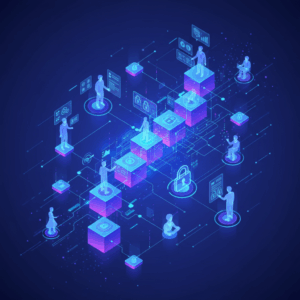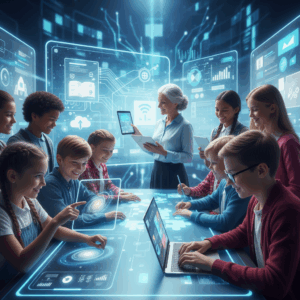AI-Driven Job Displacement
The rise of artificial intelligence is significantly altering the job market by transforming how routine tasks are performed. This shift is leading to displacement in roles heavily dependent on repetitive activities.
Advancements in AI automation are especially impacting low-skill, repetitive jobs, accelerating changes in employment patterns across manufacturing, services, and administrative sectors globally.
Routine Task Automation
AI excels at automating routine and repetitive tasks, such as data entry, customer support, and administrative duties. This leads to job losses as machines handle these functions more efficiently.
Examples include automation replacing roles like customer service representatives and medical transcriptionists, reducing demand for manual input jobs and streamlining processes across industries.
With AI systems able to perform tasks at scale, many traditional positions face decline, pushing workers to adapt or risk unemployment as automation reshapes job expectations.
Impact on Manufacturing and Service Roles
Manufacturing jobs are particularly vulnerable, as AI-driven automation replaces manual labor with robots and intelligent machines, potentially displacing millions of workers in the near future.
Service industry roles also see shifts; jobs like telemarketing and retail cashier positions are being reduced due to AI-powered tools that improve customer interaction and sales efficiency.
The ongoing displacement emphasizes a crucial need for workers to gain new skills, as AI changes the fabric of employment in both industrial and service sectors.
Emerging Roles and Opportunities
As AI transforms the job landscape, new career paths emerge, particularly in technology and data-driven fields. These roles demand specialized skills in AI development and analysis.
Beyond job creation, AI serves as a powerful augmentation tool, enhancing human capabilities and opening opportunities for collaboration between people and machines.
The changing nature of work means many existing jobs evolve, requiring employees to manage and interact with AI systems effectively, reshaping traditional roles.
New Careers in AI and Data Science
The rise of AI has fueled demand for professionals skilled in data science, machine learning, and AI programming, driving growth in high-tech job markets.
Companies increasingly recruit experts to design, implement, and maintain AI systems, encouraging innovation and ensuring technology aligns with business goals.
These emerging roles often require combining domain knowledge with technical expertise, highlighting the importance of continuous learning in dynamic industries.
AI as an Augmentation Tool
AI complements human skills by handling complex data tasks, enabling professionals like doctors and architects to focus on critical thinking and creativity.
This technology empowers workers by automating routine functions and providing insights, improving decision-making and productivity across sectors.
Rather than replacing humans, AI acts as a partner, enhancing capabilities and helping workers achieve better outcomes in their respective fields.
Transformation of Existing Jobs
Rather than eliminating jobs entirely, AI shifts many roles toward supervision, troubleshooting, and interaction with automated tools and systems.
Workers in areas like logistics or retail find their tasks evolving, requiring skills to operate and manage robotic equipment and AI-powered platforms.
Preparing for Job Evolution
This shift highlights the need for upskilling, as employees must adapt to new technology-driven responsibilities to stay relevant in the changing workplace.
Industry-Wide Changes From AI
The integration of AI technologies is revolutionizing productivity across industries, enabling businesses to operate more efficiently than ever before. This ongoing transformation boosts both output and cost savings.
Companies leveraging AI can automate complex processes, reduce errors, and optimize operations, thereby gaining a competitive edge in their markets through higher performance and streamlined workflows.
Productivity and Cost Efficiency Gains
AI-driven automation accelerates workflows and minimizes manual intervention, leading to significant productivity improvements. Businesses achieve faster task completion with fewer errors.
Cost efficiency rises as AI reduces labor expenses, lowers operational risks, and enhances resource allocation. These savings allow reinvestment into innovation and growth initiatives.
Examples include AI-enabled predictive maintenance in manufacturing, smarter inventory management in retail, and automated data analytics, all contributing to leaner and more responsive operations.
Sector-Specific Transformations
Different industries experience unique impacts from AI: healthcare benefits from diagnostic algorithms, logistics sees optimized delivery routes, and finance gains from fraud detection systems.
Retail sectors leverage AI for personalized marketing and inventory forecasting, while manufacturing adopts robotics for precision tasks—altering how value is created and delivered.
Innovations Tailored to Industry Needs
AI applications are increasingly customized, addressing specific challenges within sectors to maximize effectiveness and drive tailored outcomes that improve customer satisfaction and competitive positioning.
This trend transforms traditional business models, encouraging industries to rethink service delivery, operational strategies, and workforce roles as AI becomes integral to success.
Adapting Workforce and Policy
The rapid advancement of AI demands proactive adaptation from both workforce and policymakers. Preparing workers through skill development and supportive policies is critical to thriving in an AI-driven economy.
Strategies focusing on continuous learning, education reform, and social protections will soften the impact of job displacement and ensure inclusive growth in a transforming labor market.
Upskilling and Lifelong Learning
Continuous upskilling is essential as AI reshapes job requirements. Workers need to acquire digital literacy and AI-related capabilities to remain competitive and resilient.
Employers and governments must promote lifelong learning programs that enable employees to adapt quickly to evolving technologies and changing workplace demands.
These initiatives empower individuals to navigate career transitions, fostering a dynamic workforce that benefits from technological progress rather than being sidelined.
Education, Retraining, and Social Safety Nets
Modern education systems must integrate AI and digital skills early to prepare future generations for new roles and challenges posed by automation.
Retraining initiatives for displaced workers are vital, offering pathways to emerging industries and ensuring no one is left behind during economic shifts.
Robust social safety nets, including unemployment benefits and job transition support, provide security and encourage risk-taking as workers embrace new opportunities created by AI.






